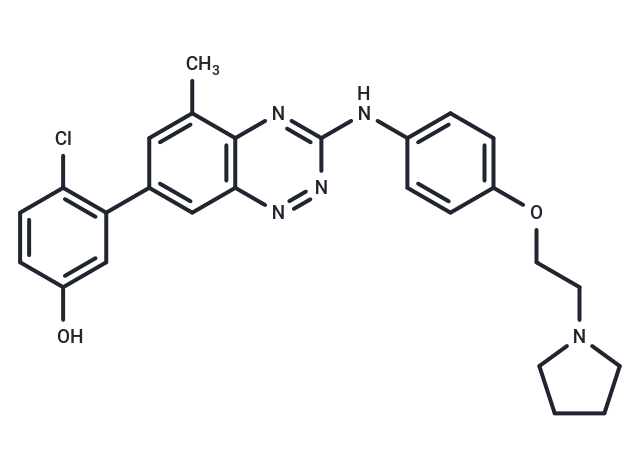Shopping Cart
- Remove All
 Your shopping cart is currently empty
Your shopping cart is currently empty

TG 100572 is a inhibitor of multi-targeted kinase which inhibits receptor tyrosine kinases and Src kinases(IC50s of 2, 7, 2, 16, 13, 5, 0.5, 6, 0.1, 0.4, 1, 0.2 nM for VEGFR1, VEGFR2, FGFR1, FGFR2, PDGFRβ, Fgr, Fyn, Hck, Lck, Lyn, Src, Yes, respectively).

| Pack Size | Price | Availability | Quantity |
|---|---|---|---|
| 25 mg | $1,520 | 6-8 weeks | |
| 50 mg | $1,980 | 6-8 weeks | |
| 100 mg | $2,500 | 6-8 weeks |
| Description | TG 100572 is a inhibitor of multi-targeted kinase which inhibits receptor tyrosine kinases and Src kinases(IC50s of 2, 7, 2, 16, 13, 5, 0.5, 6, 0.1, 0.4, 1, 0.2 nM for VEGFR1, VEGFR2, FGFR1, FGFR2, PDGFRβ, Fgr, Fyn, Hck, Lck, Lyn, Src, Yes, respectively). |
| Targets&IC50 | PDGFRβ:13 nM, FGFR1:2 nM, VEGFR2:7 nM, VEGFR1:2 nM, FGFR2:16 nM |
| In vitro | TG 100572 induces apoptosis in rapidly proliferating, but not quiescent, endothelial cell cultures[1]. TG 100572 is shown to inhibit hRMVEC cell proliferation with IC50 of 610±72 nM. in ocular endothelial cells,TG 100572 has the therapeutic potential to inhibit VEGF function, a contributing factor to pathological angiogenesis in diseases such as AMD and PDR[2]. |
| In vivo | Administering TG 100572 systemically in a mouse model of laser-induced choroidal neovascularization (CNV) significantly reduces CNV but may lead to weight loss, indicating possible systemic toxicity[1]. TG 100572 reaches its peak concentration of 23.4 μM within 30 minutes (Tmax=0.5h) in the choroid and sclera, but its presence in the retina remains notably low. Due to its short half-life in ocular tissues, topical administration of TG 100572 is necessary at least three times daily (t.i.d.) to sustain effective drug levels in the eye. The maximum achievable concentration of TG 100572 in formulations is limited to 0.7% w/v[2]. |
| Molecular Weight | 475.97 |
| Formula | C26H26ClN5O2 |
| Cas No. | 867334-05-2 |
| Relative Density. | 1.331 g/cm3 (Predicted) |
| Storage | Powder: -20°C for 3 years | In solvent: -80°C for 1 year | Shipping with blue ice. | |||||||||||||||||||||||||||||||||||
| Solubility Information | DMSO: 150 mg/mL (315.15 mM), Sonication is recommended. | |||||||||||||||||||||||||||||||||||
Solution Preparation Table | ||||||||||||||||||||||||||||||||||||
DMSO
| ||||||||||||||||||||||||||||||||||||

Copyright © 2015-2025 TargetMol Chemicals Inc. All Rights Reserved.